The End of an Era

It’s the end of an era. For the last 37 years, Gene and Joy Allen of the beautiful, remote Kispiox Valley in north-western British Columbia have bred some of North America’s most flamboyant bucking horses. Their high-kicking bloodlines run in many of today’s top rough stock herds. But eventually time catches up with us all; last May (2010) the Allens trucked the last of their herd to Alberta for a dispersal sale.
Raised in the Kispiox Valley, Gene is the son of pioneer ranchers, Marty and Dorothy Allen. The annual Kispiox Rodeo — known as the “Biggest Little Rodeo in the West” — took place right on his doorstep. During his teens, he became a rodeo aficionado, competing in most events, but found he did better in steer wrestling and team roping.
Joy, the daughter of June and Grant Nash, hails from south- eastern Idaho. By the age of 6, she’d already won the title of Miss Preston Night Rodeo Princess. Her passion for rodeo drove her to excel at barrel racing; she won All Around Cowgirl at the British Columbia Rodeo Association (BCRA), Interior Rodeo Association (IRA), Yellowhead Rodeo Cowboy Association (YRCA) and National Rodeo Association (NRA) rodeos. After her marriage to Gene, the couple continued to participate in and promote rodeo.
While Gene has won some notable awards in the rodeo arena, he says his bucking horses have done better. Thirty-seven halters for Bucking Horse of the Year at IRA, BCRA, YRCA and NRA events over the past 34 years demonstrate the success Gene and Joy achieved in raising good bucking stock.
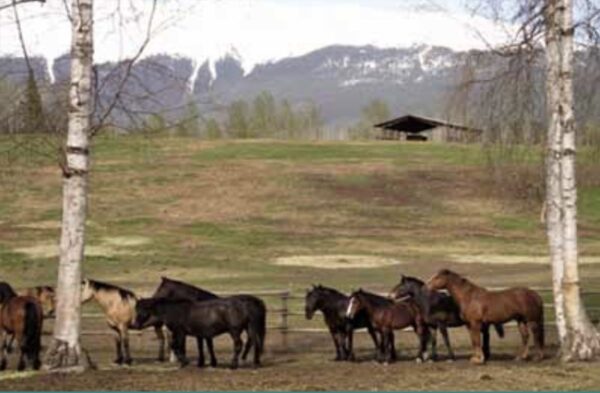
Many people have reflected aloud on the quiet disposition of many of the GJ horses. Gene reflects on the good nature of Simon, a stud that could run with mares and geldings without problems. Gene found mares to be the best buckers on his ranch and feels 75 per cent of the bucking ability of a horse comes from the mare. Flexibility, on the other hand, he says, appears to come from the stud. He refers again to Simon, who he says put flexibility in many of the bucking horses he sired. According to the Allens, Simon was a once-in- a-lifetime bucking horse. He was the offspring of a mare called Gunanoot and a stud from Rudy Ostrum named Hippo. He sired many good offspring, of which 75 per cent were fillies. Simon is buried behind the bucking chutes at the Kispiox Rodeo grounds.
Gene and Joy hosted rodeo schools for years; Gene says he feels his horses and his students both benefited from the school. Gene helped many young rough stock riders secure rodeo scholar- ships in the U.S.
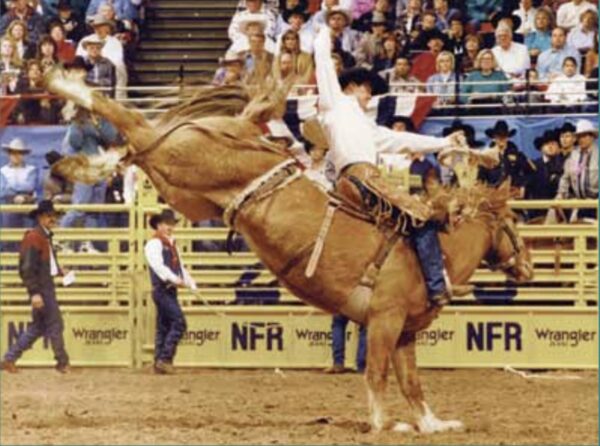
Joy has employed Animal Tracks to record the information on all their bucking horses. “Gene and his friend and mentor Iloe Flewelling remember every horse that’s ever bucked, their bloodline, who rode them and what they scored,” she says.
The Allens highest-selling horse ever was a mare called Bear Sign. She sold for $30,000. Her grand-daughter sold for $20,000 but, says Gene, for every high-selling horse there are many that sell for a great deal less.
Bear Claw sold in 1991 for $10,000. Joy recalls their first National Finals Rodeo in 1992 when Bear Claw, now bucking for Big Bend Rodeo, won Saddle Bronc of the Night with famed saddle bronc rider Billy Etbauer aboard. “I saw her coming down the alley and into the chute. She looked out into the arena and I got a lump in my throat. It was like taking your child to the Olympics.”
Bearskin, Simon’s Hide and other horses are also fondly remembered by Joy and Gene. Going into the sale, Gene says he felt the Frostbite line of horses to be their best.
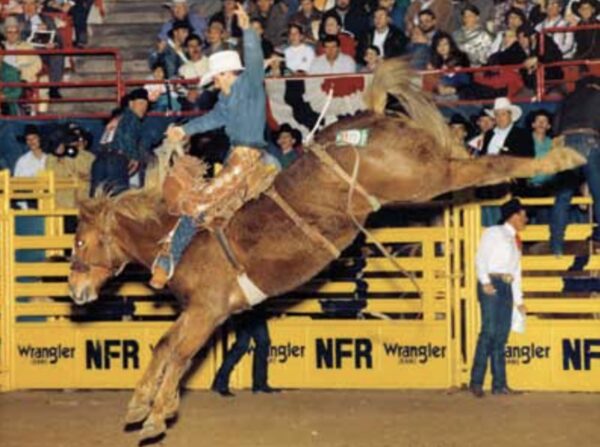
Gene credits Joy with being a vital part of their enterprise. She looked after things at home while Gene was away. Gene recalls calling home to see how things were going, noting the biggest problem seemed to be horses in the neighbours’ gardens. Both recall the time Joy found a colt badly chewed up by a cougar. Despite its injuries, it got up to nurse. Joy managed to get the foal back to the ranch and the family nursed it back to health and an active life as a bucking horse called—ironically—Meow Mix.
Gene also credits their children with being a huge help; he’s proud of all of them. Shannon is highly involved with the Skeena Water- shed Coalition and Conservation. Sue, an avid rodeo participant, grew up to train horses and works in the ranching industry in Alberta and in hunting camps. Jim is a fishing guide in a variety of places in the world. Kaleigh is studying medicine in Germany. (Mantracker fans may recall seeing Kaleigh beat Terry Grant in an episode filmed in the Hazelton area.)
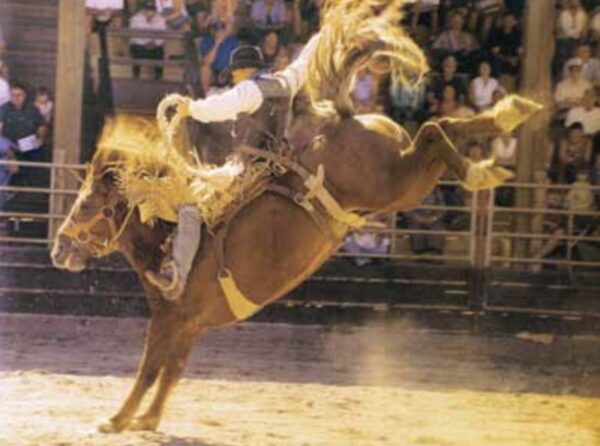
Understandably, the Allens were sad to see the horses sold; they’ve been like family. But, like family, they hope the horses move on and achieve their full potential. Sold at auction at Daines Ranch in Alberta in May 2010, prices were less than hoped for, but Gene is pleased to say goodbye to a $40,000-a-year feed bill — and the gardeners of the Kispiox Valley can now breathe a little easier.
At the 63rd Annual Kispiox Rodeo in 2010, Gene and Joy were recognized for their dedication to this event. Rodeo announcer Keith Dinwoodie read a letter from the Canadian Professional Rodeo Association (CPRA) that praised the pair on their dedication to the sport. Allison Everett gave a heart- felt speech on behalf of the British Columbia Rodeo Association. The Allens were presented with a hand- carved door by world-renowned Aboriginal artist Roy Vickers.
A letter from Jim Pippolo of the CPRA, read during the presenta-tions, noted that Gene and Joy are “partly responsible for the creation of the BCRA.” Gene was president of the Association and Joy served on the board of directors. Gene has won the Lifetime Achievement Award in the BCRA and Joy was the first recipient of the Hank Vogel Award for Rodeo Person of the Year, presented in 1992.
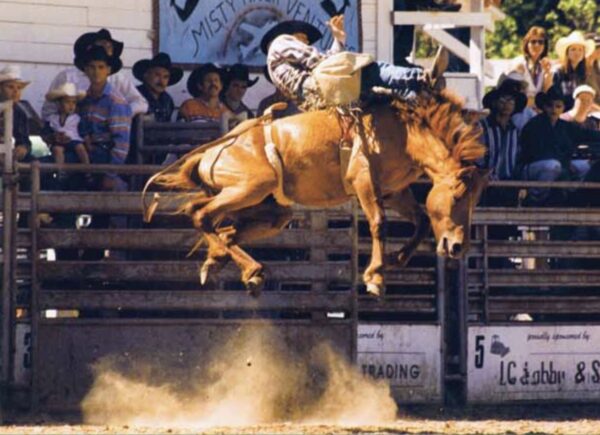
What lies ahead for the Allens? They’ll no doubt enjoy their grand- children. Both Joy and Gene are involved in their community; Joy continues to coach the Kispiox Valley Drill Team. They also run the five-star Bear Claw Lodge at The Cliffs at Kispiox River, which accommodates heliskiing, fly fishing, trail riding and conservation camps.
Gene says there are more rivers to float, mountains to climb and lakes to fish before he settles down too much. And, most definitely, the couple will remain strong rodeo supporters.
Sharon Kerr and her husband (Living Legend) Harold Kerr are semi-retired and help out on their son’s Dallaine Ranch, located in the Bulkley Valley near Smithers, B.C.
Photos by Ken Marchinkoski/Tommy Engebretson/Dan Hubbell/David Jennings/Sharon Kerr
Originally published June/July 2011













